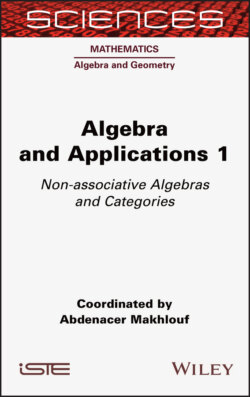Читать книгу Algebra and Applications 1 - Abdenacer Makhlouf - Страница 27
2.1. Introduction
ОглавлениеUnital composition algebras are the analogues of the classical algebras of the real and complex numbers, quaternions and octonions, but the class of composition algebras have been recently enriched with new algebras, mainly the so-called symmetric composition algebras, which play an effective role in understanding the triality phenomenon in dimension 8. The goal of this chapter is to examine the main definitions and results of these algebras.
Section 2.2 reviews the discovery of the real algebra of quaternions by Hamilton, surveys some of the applications of quaternions to deal with rotations in three- and four-dimensional euclidean spaces and then examines octonions, discovered shortly after Hamilton’s breakthrough.
Section 2.3 is devoted to the classification of the unital composition algebras, also known as Hurwitz algebras. This is achieved by means of the Cayley–Dickson doubling process, which mimics the way in which Graves and Cayley constructed the octonions by doubling the quaternions. Hurwitz algebra itself, in 1898, proved that a positive definite quadratic form over the real numbers allows composition if and only if the dimension is restricted to 1, 2, 4 or 8. These are the possible dimensions of Hurwitz algebras over arbitrary fields, and of finite-dimensional non-unital composition algebras. Some attention is paid to the case of Hurwitz algebras with isotropic norm, as this is instrumental in defining Okubo algebras later on, although the model of Zorn’s vector matrices is not touched upon.
In section 2.4, symmetric composition algebras are defined. In dimension > 1, these are non-unital composition algebras, satisfying the extra condition of “associativity of the norm”: n(x ∗ y, z) = n(x, y ∗ z). The interest lies in dimension 8, where these algebras split into two disjoint families: para-Hurwitz algebras and Okubo algebras. The existence of the latter Okubo algebras justifies the introduction of the symmetric composition algebras.
Formulas for triality are simpler if one uses symmetric composition algebras instead of the classical Hurwitz algebras. This is examined in section 2.5. Triality is a broad subject. In projective geometry, there is duality relating points and hyperplanes. Given a vector space of dimension 8, endowed with a quadratic form q with maximal Witt index, the quadric of isotropic vectors in projective space ℙ(V) contains points, lines, planes and “solids”, and there are two kinds of “solids”. Geometric triality relates points and the two kinds of solids in a cyclic way. This goes back to Study (1913) and Cartan (1925). Tits (1959) showed that there are two different types of geometric trialities; one is related to octonions (or para-octonions) and the exceptional group G2, while the other is related to the classical groups of type A2, unless the characteristic is 3. The algebras hidden behind this second type are the Okubo algebras. From the algebraic point of view, triality relates the natural and spin representations of the spin group on an eight-dimensional quadratic space, that is the three irreducible representations corresponding to the outer vertices of the Dynkin diagram D4. Here, we will consider lightly the local version of triality, which gives a very symmetric construction of Freudenthal’s magic square.
